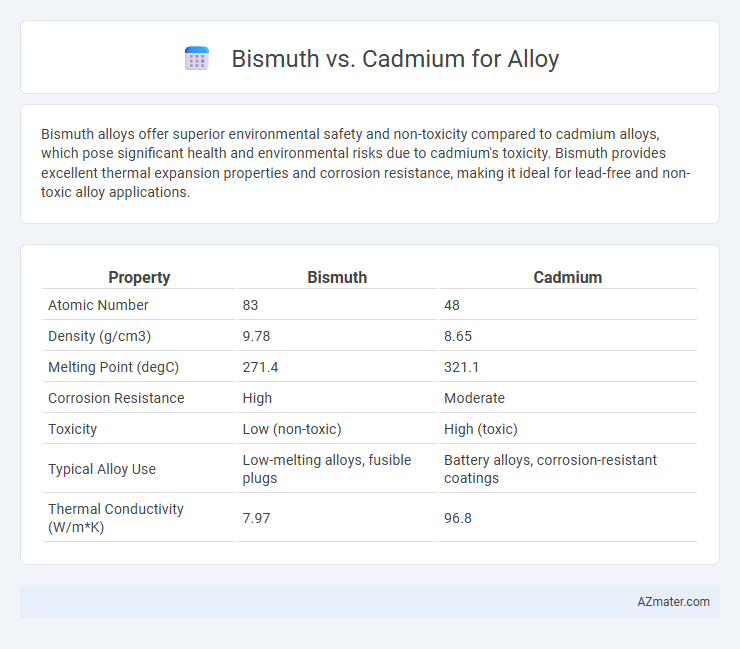Bismuth alloys offer superior environmental safety and non-toxicity compared to cadmium alloys, which pose significant health and environmental risks due to cadmium's toxicity. Bismuth provides excellent thermal expansion properties and corrosion resistance, making it ideal for lead-free and non-toxic alloy applications.
Table of Comparison
| Property | Bismuth | Cadmium |
|---|---|---|
| Atomic Number | 83 | 48 |
| Density (g/cm3) | 9.78 | 8.65 |
| Melting Point (degC) | 271.4 | 321.1 |
| Corrosion Resistance | High | Moderate |
| Toxicity | Low (non-toxic) | High (toxic) |
| Typical Alloy Use | Low-melting alloys, fusible plugs | Battery alloys, corrosion-resistant coatings |
| Thermal Conductivity (W/m*K) | 7.97 | 96.8 |
Introduction to Bismuth and Cadmium Alloys
Bismuth and cadmium alloys each offer distinct properties crucial for various industrial applications, with bismuth known for its non-toxic, low melting point characteristics and excellent machinability. Cadmium alloys provide superior corrosion resistance and enhanced strength but raise environmental and health concerns due to cadmium's toxicity. Selecting between bismuth and cadmium alloys depends on balancing performance requirements with safety and regulatory considerations.
Chemical Properties and Composition
Bismuth and cadmium alloys exhibit distinct chemical properties that influence their applications and performance. Bismuth, with an atomic number of 83 and a density of 9.78 g/cm3, is chemically stable, low-toxicity, and resistant to oxidation, making it suitable for environmentally friendly alloys. Cadmium, atomic number 48 and density 8.65 g/cm3, is more reactive, prone to oxidation, and toxic, which restricts its use despite its excellent corrosion resistance and low melting point contributions to alloys.
Physical Characteristics Comparison
Bismuth alloys exhibit lower thermal conductivity and higher density than cadmium alloys, making them effective for applications requiring stable, heavy materials with precise melting points. Cadmium alloys offer superior ductility and corrosion resistance, with lower melting temperatures and greater malleability, enhancing their use in flexible and protective coatings. The atomic mass of bismuth (208.98 u) contributes to its higher density (9.78 g/cm3) compared to cadmium's (112.41 u and 8.65 g/cm3), influencing the mechanical and thermal behavior of respective alloys.
Melting Points and Thermal Behavior
Bismuth alloys exhibit melting points ranging from about 138degC to 271degC, significantly lower than cadmium's melting point of 321degC, making bismuth ideal for low-melting point applications. Bismuth shows excellent thermal expansion stability and a sharp melting point, while cadmium alloys tend to have higher thermal conductivity but less predictable thermal behavior. The choice between bismuth and cadmium alloys directly impacts temperature-sensitive manufacturing processes due to differences in melting ranges and heat tolerance.
Toxicity and Environmental Concerns
Bismuth alloys are preferred over cadmium alloys due to bismuth's significantly lower toxicity and reduced environmental impact, making it safer for both human health and ecosystems. Cadmium is a highly toxic heavy metal known for its carcinogenic properties and persistence in the environment, leading to bioaccumulation and severe ecological damage. Regulatory restrictions and increasing environmental awareness drive the shift toward bismuth-based alloys in industries requiring non-toxic, environmentally friendly materials.
Industrial Applications and Use Cases
Bismuth alloys are preferred in industrial applications requiring non-toxic, environmentally friendly materials such as low-melting point solders and metal casting molds, offering excellent machinability and thermal conductivity. Cadmium alloys are primarily used in corrosion-resistant coatings and high-strength structural components in aerospace and electronics, though their toxicity limits widespread use. The choice between bismuth and cadmium alloys depends on balancing performance requirements with environmental and safety regulations in sectors like automotive, electronics, and manufacturing.
Alloy Formation and Compatibility
Bismuth and cadmium exhibit distinct behaviors in alloy formation due to differences in atomic size and crystal structure compatibility. Bismuth forms low-melting, brittle alloys with metals like lead and tin, often used to create fusible alloys and improve machinability, whereas cadmium tends to increase corrosion resistance and enhance strength when alloyed with copper and nickel. The limited solid solubility of bismuth in most metals contrasts with cadmium's better solubility and ductility in alloys, affecting their compatibility and performance in various industrial applications.
Mechanical Strength and Durability
Bismuth alloys offer lower mechanical strength compared to cadmium alloys, which exhibit superior tensile strength and hardness, making them more suitable for high-stress applications. Cadmium alloys demonstrate enhanced durability under cyclic loading and corrosion resistance, providing longer service life in industrial environments. Bismuth alloys are preferred for low-to-moderate strength uses with environmental safety benefits due to cadmium's toxic nature.
Cost and Availability Factors
Bismuth offers a cost-effective alternative to cadmium in alloy production due to its lower toxicity and greater regulatory acceptance, which reduces handling and disposal expenses. Cadmium's limited availability and stricter environmental restrictions increase its procurement and compliance costs, making it less economically attractive. The wider availability of bismuth deposits, particularly in China and South America, ensures a more stable supply chain for alloy manufacturers.
Choosing the Right Alloy: Bismuth vs Cadmium
Bismuth and cadmium alloys each offer unique advantages for specific industrial applications, with bismuth favored for its non-toxic and environmentally friendly properties, making it ideal for lead-free solders and low-melting-point alloys. Cadmium alloys provide superior corrosion resistance and enhanced mechanical strength, often used in aerospace and electronics where durability under stress is critical. Selecting the right alloy depends on balancing environmental safety, mechanical performance, and application-specific requirements.

Infographic: Bismuth vs Cadmium for Alloy
 azmater.com
azmater.com